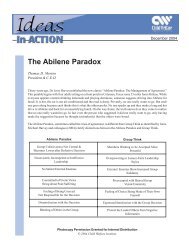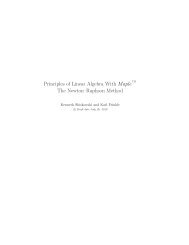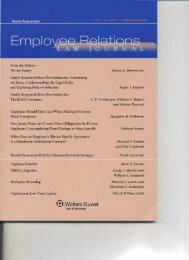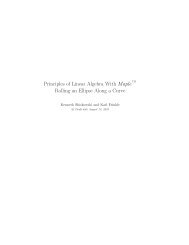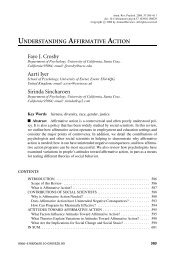Do Nice Guysâand GalsâReally Finish Last - Southeastern ...
Do Nice Guysâand GalsâReally Finish Last - Southeastern ...
Do Nice Guysâand GalsâReally Finish Last - Southeastern ...
Create successful ePaper yourself
Turn your PDF publications into a flip-book with our unique Google optimized e-Paper software.
2 JUDGE, LIVINGSTON, AND HURST<br />
1980s, but convergence slowed in the 1990s (Blau & Kahn, 2006),<br />
and despite the many contributing factors studied, researchers have<br />
not been able to explain the gender wage gap entirely.<br />
Traditionally, there are two categories of explanations for the<br />
gender wage gap. Demand-side explanations are based on examinations<br />
of the influence of structural and institutional characteristics<br />
of the labor market (e.g., discrimination; Auster, 1989; Blau<br />
& Ferber, 1992). Supply-side explanations are drawn from investigations<br />
of the effects of differences in human capital (e.g.,<br />
Weinberger & Kuhn, 2010) and career decision making (e.g.,<br />
Jackson & Grabski, 1988) between men and women. These categories<br />
of explanations may also help explain the effect of agreeableness<br />
on income and the joint influence of agreeableness and<br />
gender.<br />
Agreeableness and Earnings<br />
One has simply to look to Costa and McCrae’s (1992) six facets<br />
of agreeableness—trust, straightforwardness, altruism, compliance,<br />
modesty, and tender-mindedness—to get an idea of what an<br />
agreeable person is like. But what of people low in agreeableness?<br />
Are they antagonistic boors with no concern for their relationships?<br />
On the one hand, research on the variability of trait manifestation<br />
in behavior (Fleeson & Gallagher, 2009) indicates that,<br />
on average, people low in agreeableness are basically amicable.<br />
They are just slightly more likely than people high in trait agreeableness<br />
to behave disagreeably in certain situations by, for instance,<br />
aggressively advocating for their position during conflicts<br />
(Van de Vliert & Euwema, 1994). On the other hand, high levels<br />
of disagreeableness may be associated with psychopathy (Derefinko<br />
& Lynam, 2006), suggesting that disagreeable individuals<br />
may be predisposed toward antisocial or deviant behaviors<br />
(Decuyper, De Pauw, De Fruyt, De Bolle, & De Clercq, 2009).<br />
However, most disagreeable individuals are unlikely to suffer from<br />
clinical psychological disorders, and, as evident in the myriad acts<br />
of corporate malfeasance reported in the literature (Balch & Armstrong,<br />
2010), antisocial behaviors do not preclude earning higher<br />
incomes.<br />
Agreeableness is only modestly related to job performance in<br />
general, but it does confer benefits in the interpersonal dimension<br />
of job performance (Hurtz & <strong>Do</strong>novan, 2000). Given the increasing<br />
reliance of organizations on teams, it would seem that people<br />
high in agreeableness would have at least a slight economic<br />
advantage over those low in agreeableness. The fact that researchers<br />
repeatedly report the opposite is puzzling (Mueller & Plug,<br />
2006; Ng et al., 2005; Nyhus & Pons, 2005; Rode et al., 2008;<br />
Spurk & Abele, 2010), and none have offered more than minimal<br />
explanations for this finding. Yet, as with the association between<br />
gender and income, both supply- and demand-side forces may be<br />
responsible.<br />
From the supply side, people high in agreeableness may not<br />
translate their human capital into financial gain as well as people<br />
low in agreeableness. According to McCrae and Costa’s (1996)<br />
five-factor conceptualization, personality traits affect individuals’<br />
adaptations to their environment, including the ways in which they<br />
self-regulate. If highly agreeable people are primarily motivated by<br />
the goal to build and maintain positive relationships with others<br />
(Digman, 1997), this may conflict with other types of goals that<br />
promote extrinsic career success, as suggested by Spurk and<br />
Abele’s (2010) finding that the negative relationship between<br />
agreeableness and income was mediated by career advancement<br />
goals. Setting goals to build their reputation or advance their<br />
organizational position might be viewed by highly agreeable people<br />
as competitive behavior, undermining their desire to maintain<br />
social harmony. On the other hand, because people low in agreeableness<br />
do not prize smooth interpersonal interactions as a basic<br />
goal and, in fact, value competition, they may be more likely to<br />
behave in ways that advance their interests relative to others. In<br />
particular, possibly stemming from their high sense of psychological<br />
entitlement (Campbell, Bonacci, Shelton, Exline, & Bushman,<br />
2004) and lower level of willingness to compromise their selfinterests<br />
(Barry & Friedman, 1998), disagreeable bargainers reach<br />
more favorable individual settlements in distributive negotiations<br />
(Barry & Friedman, 1998; Liu, Friedman, & Chi, 2005). This may<br />
be one of the primary reasons for the negative relationship between<br />
agreeableness and earnings—disagreeable individuals are less<br />
likely to settle for less favorable outcomes when engaged in<br />
negotiations over their pay or other outcomes.<br />
The aspiration toward harmonious social relationships may also<br />
lead highly agreeable people to adhere excessively to social norms<br />
(Paulhus & Trapnell, 2008). There is evidence that, although<br />
people high in agreeableness engage in more altruistic behaviors at<br />
work (Ilies, Scott, & Judge, 2006; LePine & van Dyne, 1998), they<br />
are less likely to enact voice behaviors that constructively challenge<br />
existing practice (LePine & van Dyne, 1998). Although<br />
altruistic behaviors are a facet of performance, they involve selfsacrifice<br />
and are often not rewarded (LePine & van Dyne, 1998).<br />
Voice behaviors may, on the other hand, attract rewards, particularly<br />
when they are directed toward persuading others of the value<br />
of one’s ideas.<br />
From a demand-side perspective, it is perhaps counterintuitive<br />
that employers may favor people low in agreeableness. People<br />
evaluate each other on the two basic dimensions of warmth/<br />
communion and competence/agency (Able, Cuddy, Judd, & Yzerbyt,<br />
2008). Generally, communion is privileged over competence<br />
in overall evaluations of people (Wojciszke & Abele, 2008). Based<br />
on this, one might expect for employers to value highly agreeable<br />
people more. But Wojciszke and Abele (2008) found that, when an<br />
individual’s goal achievement is entwined with the behavior of the<br />
person they are evaluating, as in the work environment, the ranking<br />
of communion and agency are flipped: Perceptions of agency<br />
become more important. Thus, agreeable people would not necessarily<br />
reap advantages from being perceived as highly warm by<br />
their employer. Yet less agreeable people might gain from not<br />
being perceived as warm.<br />
Although being disagreeable does not mean that one is more<br />
competent or agentic—communion and agency are not opposite<br />
ends of the same construct (Wiggins, 1991)—it may imply as<br />
much in the minds of employers. People who are low in agreeableness<br />
may be perceived as more competent by virtue of their<br />
lack of warmth (Benyus et al., 2009). Amabile and Glazebrook<br />
(1982) found that people who were highly critical of others were<br />
rated as more competent than those offering favorable evaluations.<br />
Furthermore, in an experimental study, Tiedens (2001) found that<br />
people recommended a higher status position and higher pay for<br />
job applicants who expressed anger—a display that is more likely<br />
among disagreeable people (Jensen-Campbell, Knack, Waldrip, &<br />
Campbell, 2007; Meier & Robinson, 2004). The relationship be-



